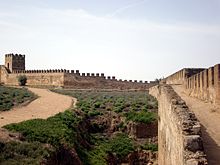
Badajoz is a city of 150,000 people (2018) in Extremadura, in the west of Spain, close to the border with Portugal. The city is crowned by the ruins of a Moorish castle and overlooks the Guadiana river, which flows between the castle-hill and the powerfully armed fort of San Cristobal. The architecture of Badajoz is indicative of its tempestuous history; even the Badajoz Cathedral, built in 1238, resembles a fortress, with its massive walls.
Understand
Badajoz primarily is now a commercial city. Because of its location, the city shares a considerable transit trade with Portugal. The service sector is dominant in the city. Notable industries include manufacturing of linen, woollen and leather goods, hats, pottery, and soap.
Badajoz is home to the CD Badajoz and AD Cerro de Reyes football clubs and the AB Pacense basketball club.
History
It was settled by Romans as "Civitas Pacensis", and then by Visogoths. Badajoz was conquered by the Moors in the 8th century, and became a Moorish kingdom, the Taifa of Badajoz. After the reconquista, the area was disputed between Spain and Portugal for several centuries with alternating control resulting in several wars including the Spanish War of Succession (1705), the Peninsular War (1808–1811), the Storming of Badajoz (1812), and the Spanish Civil War (1936). Spanish history is largely reflected in the town.
Climate
Badajoz has mild winters but with more common temperatures below zero and hot summers being sometimes a year at 40 °C or more. The climate of Badajoz has drastic changes between the summer and winter
Get in

It is served by Badajoz Railway Station and Badajoz Airport.
Get around
See
- 1 Alacazaba de Badajoz. This Moorish citadel built in the 9th century was fortified by the Almohad caliph. The Alcazaba served as the primary residences for the rulers of the Taifa of Badajoz in the 11th and 12th centuries. The Torre de Espantaperros has a height of 30 metres (98 ft) and is built of mud and mortar. It has an octagonal plan with a quadrangular structure that once provided scenic views of the countryside. The name is attributed to the sharp ringing of a bell that was one installed in the tower. The building attached to it, built in the 16th century called La Galera, once served as city hall, then a prison and finally it is now the Archaeological Museum. A well-tended garden surrounded this monument where archeological finds from the Visigothic, Roman, and other periods were found.

- Jardines de la Galera date back to the 10th century. They are nestled between the Torre de Espantaperros and the Chemin de ronde, within the Alcazaba. Many Alhambran ruins still exist within the gardens. The gardens provided a respite for prisoners sentenced to the gallows in Seville.
- Other parks and gardens include Castelar, which has a central pond and several monuments dedicated to the romanticist writer Carolina Coronado and to Luis Chamizo Trigueros, la Legión, Rivillas y Calamón, San Fernando, and La Viña.
- The city also has a water and leisure park, called the Lusiberia.
- 2 Museo de Bellas Artes de Badajoz.
- 3 Catedral de San Juan Bautista.
- 4 Museo Extremeño e Iberoamericano de Arte Contemporáneo (MEIAC) (Ibero-American Museum of Contemporary Art), C / Museo, s / n, ☏ 34 924 013060. Tuesday to Saturday 10:00-14:00, 17:30-20:00; Sundays 10:00-14:00; holidays 10:00-15:00. It is housed in a building designed by the architect José Antonio Galea. It is on the site of the former Pretrial Detention and Correctional Center, which was built in the mid-1950s on the grounds of the former 17th-century Fort of Pardaleras. The museum has a collection of art works of Spanish, Portuguese, and Latin American artists.
Do
Buy
The main shopping street is Menacho, where most national and international chains, including Zara and Bershka, are located. There are also small curious boutiques.
The Centro Comercial Abierto Menacho is the largest outdoor shopping centre in Extremadura, and it is visited by thousands of Portuguese a year.
You can buy food in so many supermarkets. There is one in city centre, Eroski, which is in San Francisco square.
Eat
Best eating is in Elvas, the nearest village of Portugal. (it's only 5 km from Badajoz).
If you want to eat products of the region you can go around the old town, where you will find many bars and restaurants where you can eat iberics and meat of Extremadura. Also you can have a small beer with a free "tapa".
La Santina is a very good place to stay and have a dish of Iberic meat, ham.
La casona de arriba is a very good place to have a beer before lunch, with a small tapa.
